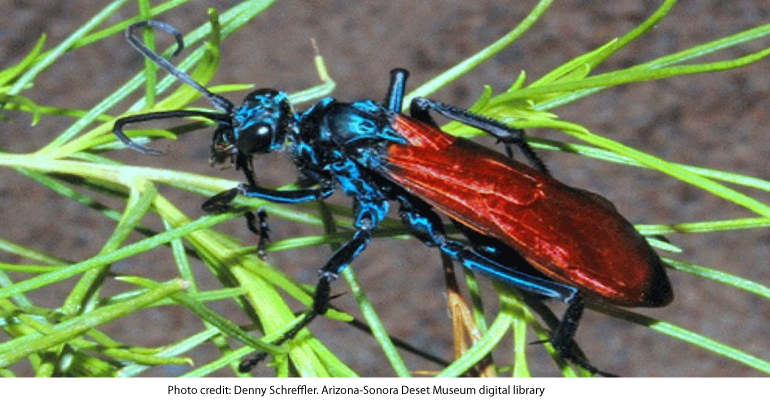
Last Sunday I wrote about the 13 most dangerous venomous animals of the southwest. One animal that didn’t make the list is the Pepsis wasp, also known as the Tarantula Hawk. It’s not as venomous as the others, but it holds the distinction of delivering the most painful sting of any animal in the world, and they are common in southern Arizona.
There are 15 species of Pepsis wasps in North America, some up to four inches long. The most common species in Arizona appears to be Pepsis formosa, a bluish-black wasp with orange wings. These can get up to two inches long. You can see many photos of the Pepsis wasp at the Arizona-Sonora Desert Museum’s digital library.
Just how painful is the sting? Well, on the Schmidt Sting Pain Index, Pepsis wasps (and Bullet Ants) register a 4, the maximum. Africanized bees, yellow jackets, hornets, and bumble bees register a 2. Dr. Justin Schmidt, an entomologist, retired from the U.S. Department of Agriculture’s Tucson Carl Hayden Bee Research Center, allowed himself to be stung by a variety of insects so he could judge the amount of pain. How’s that for a job? Schmidt poetically describes the Pepsis wasp sting as “Blinding, fierce, shockingly electric. A running hair drier has been dropped into your bubble bath.” (He describes the sting of a Bullet ant as pure, intense, brilliant pain. Like fire-walking over flaming charcoal with a 3-inch rusty nail in your heel.) The pain from a Pepsis wasp sting is said to last only three (very long) minutes.
Although their sting is traumatic, Pepsis wasps are not aggressive and it takes much provocation to get one to sting you. So, don’t try to catch one in your bare hands. Many times at the Arizona-Sonora Desert Museum my tour group and I would stand under a flowering tree near the prairie dog enclosure while that tree hosted hundreds of Pepsis wasps feeding on the nectar. No one was ever stung.
Only the females sting (but males may fake it), because the stinger is derived from the ovipositor, the egg-laying organ. You can distinguish females from males by the curled antennae of the female.
See the Bug guide for more photos.
Pepsis wasps are most active in the summer although they do try to avoid the hottest part of the day. They are found around flowers or on the ground in search of prey. The adult Pepsis wasps feed on nectar and pollen. They are called tarantula hawks because the females hunt tarantulas (and other large spiders) to use in the wasp’s reproductive cycle. The Pepsis wasp will approach a tarantula and cause the spider to rear its legs, thus exposing its abdomen. The wasp will sting the spider to paralyze it. The wasp will lay an egg on the paralyzed spider and drag it to a hole, bury it, and cover up the hole. When the wasp egg hatches, the larvae eats the flesh of the living tarantula for about 35 days, then spins a cocoon and pupates over the winter. If the wasp egg fails to hatch, the spider can recover.
Most predators avoid the Pepsis wasp. However, roadrunners and bullfrogs are known to tackle them.
By the way, Pepsis formosa is the New Mexico State Insect. (Arizona’s state insect is the two-tailed Swallowtail, a butterfly.)
Videos of Pepsis wasp attacking a tarantula:
Part 1, the attack: http://www.youtube.com/watch?v=5C1wFxEIj8E
Part 2, the kill: http://www.youtube.com/watch?v=D56lxph_WlI
Copyrighted by Jonathan DuHamel. Reprint is permitted provided that credit of authorship is provided and linked back to the source.
